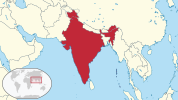

概述
[编辑]泰米尔语是世界上的排名第20大语言。按照人口计算,讲泰米尔语的人约占世界人口的1.06%。 泰米尔语是前殖民时代该地区主要的贸易语言之一。 诸如艾努鲁瓦这样的泰米尔商业行会在东南亚很活跃,在亚洲和非洲的部分地区(例如中国,柬埔寨,埃及和印度尼西亚)也发现了泰米尔语铭文和硬币。[1]
在18世纪,英国和法国的殖民统治者将泰米尔人带到了亚洲和非洲的许多地区,在这些地区,许多国家的泰米尔语使用者数量相当可观,具有重要的文化影响。 马来西亚本身有超过2,000,000讲泰米尔语的人。 泰米尔语被印度政府认可为古典语言,它是印度第一种公认的古典语言[2],它也是印度的22种官方语言之一[3]。
按人口排列
[编辑]主权国家
[编辑]
| 主权国家 | 地区 | 人口 | 状态 | 其他官方语言 |
|---|---|---|---|---|
| 亚洲 | 66,742,402[4] | 主权国家,联合国会员国 | 印度语言、英语、印地语 | |
| 亚洲 | 688,591[6] | 主权国家,联合国会员国 | 英语 马来语 华语 | |
| 亚洲 | 5,007,003[8] | 主权国家,联合国会员国 | 僧伽罗语 英语 |
附属实体
[编辑]| 实体属地 | 主权国家 | 属地人口 | 行政状态 |
|---|---|---|---|
| 印度共和国 | 2,600 | 印度自治市 | |
| 印度共和国 | 1,244,464 | 印度中央直辖区 | |
| 印度共和国 | 72,138,958 | 印度的邦 |
公认为少数民族语言的国家和地区
[编辑]| 主权国家 | 人口 | 备注 |
|---|---|---|
| 650,000 | 南非共和国宪法,1996年-第1章:成立条款规定:“由国家法律设立的泛南非语言委员会必须促进和确保尊重泰米尔语”,以及其他少数民族语言。[12] | |
| 4,800,000 | 马来西亚政府承认泰米尔语与中文一起为少数民族语言。 “民族”学校的教学语言是泰米尔语或华语。[13] | |
| 72,089 | 泰米尔人是最早由法国带来的毛里求斯移民。 后来,英国人将泰米尔人带到与法国人的战斗中。作为一种认可,泰米尔语被用作毛里求斯的货币。泰米尔正在对毛里求斯的货币使用。[14] |
部分认可和不认可的领土
[编辑]| 政治实体 | 所属国家 | 备注 |
|---|---|---|
| 泰米尔伊拉姆 | 主张对斯里兰卡北部和东部和普塔勒姆区拥有主权,現已滅亡[15][16] | |
| 要求在印度拥有单独的建制的领土。[17] |
前领土的代表及泰米尔语为官方语言的从属实体
[编辑]| 实体 | 主权国家 | 人口 | 状态 | 备注 |
|---|---|---|---|---|
| 印度 | 10,572 | 印度的邦 | 泰米尔曾经在哈里亚纳邦获得名义上的正式地位,但后来在2010年被旁遮普人的旁遮普语取代。[18] |
参见
[编辑]- 语言列表、官方语言列表、各国官方语言列表
- 英属印度
- 印度语言
- 阿拉伯语国家和地区列表
- 西班牙语国家和地区列表
- 葡萄牙语国家和地区列表
- 法语国家和地区列表
- 英语国家和地区列表
- 俄语国家和地区列表
- 汉语国家和地区列表
注释
[编辑]参考文献
[编辑]- ^ Tamil Inscriptions. Archaeology India. [2019-12-23]. (原始内容存档于2013-01-17).
Tamil Inscriptions of Egypt and Thailand
- ^ Stein, Burton. Circulation and the Historical Geography of Tamil Country. The Journal of Asian Studies. 1977-11, 37 (1): 7–26. ISSN 0021-9118. doi:10.2307/2053325 (英语).
- ^ 3.0 3.1 Languages Included in the Eighth Schedule of the Indian Constution | Department of Official Language | Ministry of Home Affairs | GoI. www.rajbhasha.nic.in. [2019-03-20]. (原始内容存档于2018-05-12).
- ^ 2001 Census of India. National Portal of India. [2019-12-23]. (原始内容存档于2009-05-19).
- ^ Wong, Aline. Education in a Multicultural Setting - The Singapore Experience. Ministry of Education, Government of Singapore. 2000-11-24 [2009-01-18]. (原始内容存档于2008-05-04).
There are four official languages: English, Chinese, Malay and Tamil.
- ^ Department of Statistics, Ministry of Trade and Industry, Republic of Singapore (PDF). Census of population 2010. Department of statistics Singapore. (原始内容 (PDF)存档于2017-05-16).
- ^ Language Dept Sri Lanka. [2019-12-23]. (原始内容存档于2019-01-06).
Tamil and Sinhala official language of Sri Lanka
- ^ Census of Population and Housing of Sri Lanka, 2012 (PDF). Census of Population and Housing of Sri Lanka, 2012. Department of Census and Statistics-Sri Lanka. (原始内容存档 (PDF)于2016-03-04).
- ^ Auroville - A to Z. [2018-08-09]. (原始内容存档于2018-08-09).
- ^ The Pondicherry Official Languages Act, 1965 (PDF). [2018-08-09]. (原始内容存档 (PDF)于2014-09-11).
- ^ The Tamil Nadu Official Language Act, 1956 (PDF). [2018-08-09]. (原始内容存档 (PDF)于2018-09-14).
- ^ Constitution of the Republic of South Africa, 1996 - Chapter 1: Founding Provisions - South African Government. [2019-12-23]. (原始内容存档于2014-10-28).
- ^ National Identity and Minority Languages. [2019-12-23]. (原始内容存档于2019-06-30).
- ^ A Brief History of the Tamils of Mauritius. [2019-12-23]. (原始内容存档于2016-03-07).
- ^ 存档副本. [2019-12-23]. (原始内容存档于2019-12-23).
- ^ 存档副本. [2019-12-23]. (原始内容存档于2020-02-04).
- ^ 存档副本. [2019-12-23]. (原始内容存档于2007-05-26).
- ^ Punjabi edges out Tamil in Haryana. [2018-08-09]. (原始内容存档于2015-01-02).














